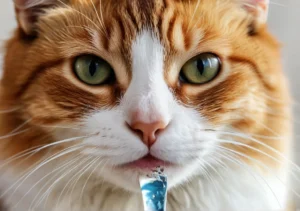Cats are known for their agility, grace, and sometimes, their mysterious behavior. If you’ve noticed that your furry friend is having trouble breathing, you may be wondering – why can’t my cat breathe properly?
Cats can experience breathing difficulties for a variety of reasons, ranging from respiratory infections to heart conditions. Let’s explore the possible causes of your cat’s labored breathing and what you can do to help ease their discomfort.
Signs of Breathing Issues in Cats
Hey there, worried cat parent! If you notice wheezing, coughing, or even open-mouth breathing in your furry friend, it might indicate some breathing issues. Cats are usually masters of stealth and grace, so any respiratory issues should be a red flag. Keep a close eye on these signs and don’t hesitate to reach out to your vet if you spot any of them.
Common Causes of Breathing Problems in Cats
So, why can’t your kitty catch a breath? Well, there are a few potential culprits. Feline asthma, which causes bronchial constriction, could be to blame. Heartworm disease can also lead to breathing difficulties in cats, even though it’s more commonly associated with dogs. Upper respiratory infections are another sneaky culprit that can make breathing a struggle for your feline friend. If you suspect any of these issues, it’s best to consult with your vet to get to the bottom of it and find the best treatment plan for your furball.
- An additional unique insight: Beyond health issues, environmental factors like smoke, pollen, or dust can also trigger breathing problems in cats. Keeping a clean and well-ventilated space can help reduce these irritants and alleviate your cat’s respiratory issues.
When to Seek Veterinary Care
If your cat is having difficulty breathing, it’s crucial to seek veterinary care immediately. Persistent or worsening breathing problems can be a sign of a serious underlying issue that requires professional attention. Don’t delay in seeking help, as early intervention can greatly improve your cat’s prognosis.
Diagnostic Tests for Breathing Issues
When your cat is experiencing breathing difficulties, your veterinarian may recommend several diagnostic tests to determine the root cause. X-rays can help identify any abnormalities in the lungs or airways, while blood tests can provide valuable information about your cat’s overall health.
Additional Unique Insight
In addition to X-rays and blood tests, bronchoscopy can be a valuable diagnostic tool for pinpointing respiratory issues in cats. This procedure involves inserting a thin, flexible tube with a camera into the airways to visualize any abnormalities directly. It can provide a more detailed assessment of the respiratory system and help guide treatment decisions.
Remember, early detection and diagnosis are key to effectively treating your cat’s breathing problems. Don’t hesitate to consult your vet for a thorough evaluation and appropriate care.
Treatment Options for Breathing Troubles
If you notice your cat having difficulty breathing, it can be a worrying situation. The first step is to take them to the vet for a thorough examination. Your vet may recommend treatment options such as medication to help alleviate respiratory issues. This could include antibiotics to treat infections or bronchodilators to help open up airways. In severe cases, your cat may require oxygen therapy to help them breathe more comfortably. Additionally, making lifestyle changes such as reducing exposure to smoke, dust, or other respiratory irritants can also improve your cat’s breathing.
Preventing Breathing Problems in Cats
Prevention is always better than cure when it comes to your cat’s respiratory health. To help prevent breathing problems in your furry friend, make sure to keep your home environment clean and free of dust and mold. Reduce stress in your cat’s life by providing a safe and quiet space for them to relax. Regular vet check-ups can also help catch any potential issues early on and ensure your cat’s respiratory health is in top condition. Remember, a healthy cat is a happy cat!
Tips for Preventing Breathing Problems:
- Keep the litter box clean and well-ventilated to reduce potential respiratory irritants.
- Provide fresh water daily to keep your cat hydrated, which is essential for respiratory health.
- Offer regular exercise and playtime to keep your cat active and maintain a healthy weight, which can prevent breathing difficulties.
- Avoid smoking around your cat as secondhand smoke can exacerbate respiratory issues.
- Use a mild detergent when washing your cat’s bedding to prevent respiratory irritation.
Fun Facts About Feline Respiratory Systems
Did you know that cats have a unique respiratory system that differs from humans’? Cats have a higher respiratory rate than humans, breathing around 20 to 30 times per minute compared to our 12 to 16 times per minute. This faster breathing rate helps them get more oxygen into their bodies efficiently.
Another interesting fact is that cats have a very sensitive sense of smell, thanks to their complex nasal structure. Their ability to detect odors is about 14 times stronger than humans’, with a specialized organ called the vomeronasal organ that helps them analyze scents more effectively.
Additionally, cats are obligate nasal breathers, meaning they primarily breathe through their noses, unlike humans who can switch between breathing through their nose and mouth. This unique adaptation allows cats to better regulate their breathing and maintain a steady oxygen supply, especially during strenuous activities like hunting or play.
Breathing Exercises for Cats
Just like humans, cats can benefit from simple breathing exercises to improve their lung function and overall respiratory health. One effective exercise is controlled breathing, where you gently place your hand on your cat’s chest as they breathe in and out slowly. This can help your cat relax, reduce stress, and improve their breathing patterns.
Another helpful technique is encouraging deep belly breathing in your cat. By gently pressing down on their abdomen as they breathe, you can help them engage their diaphragm more effectively, promoting better airflow into their lungs.
Additionally, incorporating interactive play sessions that encourage your cat to engage in active movement can also help strengthen their respiratory muscles. Activities like chasing a toy or climbing a cat tree can increase your cat’s lung capacity and improve their overall respiratory function over time.
Remember, always consult your veterinarian before beginning any new exercise routine for your cat, especially if they are experiencing difficulty breathing or respiratory issues. Your vet can provide tailored advice and guidance to ensure your cat stays healthy and happy.
And one more thing – don’t forget to regularly clean your cat’s living environment to reduce dust, allergens, and other respiratory irritants that can affect their breathing. Your cat will thank you for the fresh, clean air!
Alex, a passionate animal lover, has experience in training and understanding animal behavior. As a proud pet parent to two dogs and three cats, he founded AnimalReport.net to share insights from animal experts and expand his knowledge of the animal kingdom.




